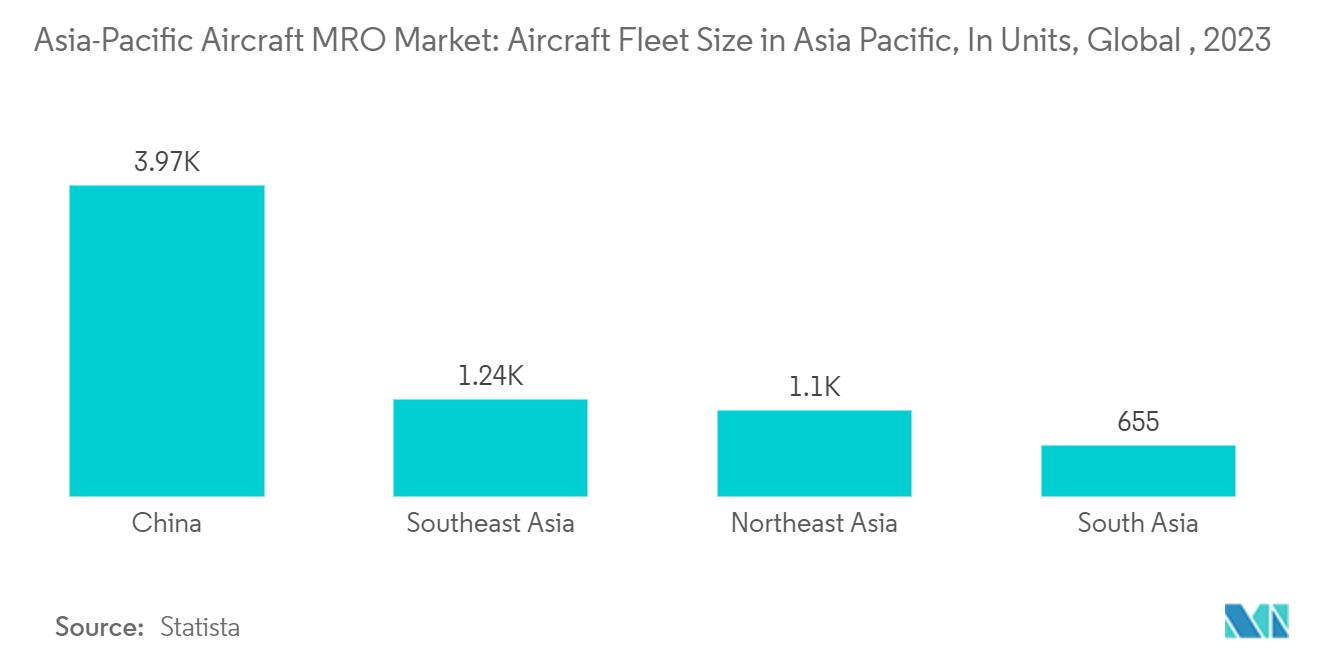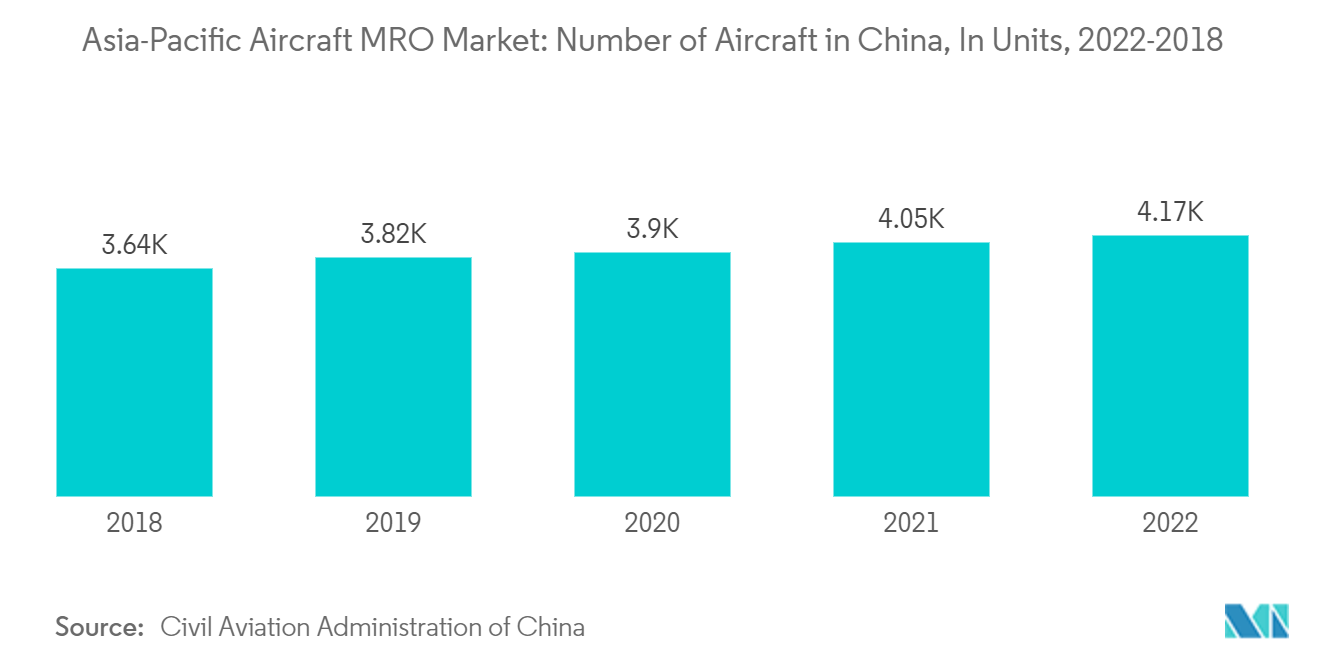Market Trends of Asia-Pacific Aircraft MRO Industry
The Commercial Aviation Segment is Projected to Dominate the Market During the Forecast Period
The Asia-Pacific commercial aviation segment, buoyed by an increasing fleet, is witnessing significant growth. Airlines, in response to escalating air travel demand, are rapidly expanding their fleets. This surge in fleet size is driving up the need for maintenance, repair, and overhaul (MRO) services to ensure airworthiness. The advent of next-gen aircraft models, exemplified by the likes of Boeing 787 and Airbus A350, necessitates cutting-edge maintenance solutions, fueling a global demand for specialized MRO services. These sophisticated aircraft, laden with advanced technologies, underscore the need for top-tier MRO services to uphold their intricate systems.
Technological advancements, including predictive maintenance, AI, and IoT, are reshaping the MRO landscape by predictive maintenance, leveraging real-time data and AI algorithms, forecasting maintenance requirements, and curbing productivity losses from downtime. IoT devices enable continuous component monitoring, providing vital data for proactive maintenance. These innovations bolster reliability, safety, cost-efficiency, and turnaround times, heightening the appeal and significance of MRO services in commercial aviation.
Furthermore, stringent regulatory frameworks and safety standards mandated by aviation authorities like China's CAAC and India's DGCA necessitate meticulous maintenance checks. These regulations, aimed at bolstering aircraft safety and airworthiness, drive up the demand for MRO services. Given the emphasis on safety, frequent inspections, overhauls, and repairs are mandated, further propelling the MRO market. Adhering to these regulations ensures traveler safety and minimizes operational disruptions.
The rise of low-cost carriers (LCCs) in Asia has significantly impacted the MRO market. LCCs, known for their high-frequency, short-haul model, experience accelerated aircraft wear and tear, demanding frequent maintenance. With typically lean maintenance schedules, LCCs heavily rely on MRO service providers for fleet upkeep. LCCs are increasingly focusing on operational cost efficiencies to stay competitive, placing a premium on affordable and reliable MRO services. As the demand for streamlined and efficient maintenance solutions rises, the LCC segment is poised for direct growth.
Several countries in Asia-Pacific, including Singapore, Malaysia, and China, are emerging as MRO hubs. These countries boast strategic advantages such as favorable geographic locations, skilled labor pools, and proactive government policies, making them attractive to investors. Notable examples include Singapore's Seletar Aerospace Park and Malaysia's Subang Aerotech Park, which are witnessing substantial investments in MRO infrastructure. The development of these hubs bolsters the region's MRO capabilities, positioning it as the go-to destination for airlines seeking comprehensive maintenance solutions. The burgeoning commercial market can access cutting-edge maintenance services with advanced MRO facilities concentrated in these hubs.
Partnerships and alliances among airlines, exemplified by code-sharing agreements and joint ventures, are pivotal in driving the market's growth. These collaborations facilitate resource and maintenance facility sharing, cutting costs and enhancing operational efficiency. Alliances like Star Alliance and Oneworld empower member airlines to leverage the same MRO service providers, ensuring superior service quality and availability. This trend of consolidation and collaboration in the aviation sector is fueling the demand for standardized, high-quality MRO services, thereby bolstering the Asian commercial aviation segment. Such partnerships also foster innovation, elevating maintenance operations practices and further amplifying the market's growth. For instance, in September 2023, Honeywell International Inc. and Guangzhou Aircraft Maintenance Engineering Co. Ltd (GAMECO) signed a milestone license agreement. Under this deal, GAMECO secures accreditation as Honeywell's third-party channel partner, marking a significant shift as Honeywell extends licenses to third-party partners for the first time in the Chinese airline MRO sector. This move is part of a broader five-year non-exclusive agreement primarily aimed at enhancing MRO operations for China Southern Airlines. Moreover, there are plans to expand these services to other airlines in Asia-Pacific. This strategic partnership broadens GAMECO's market reach and enhances the repair capabilities of Chinese airlines. Leveraging Honeywell's extensive network and technological prowess, GAMECO is poised to elevate its MRO services, ensuring a superior offering. Beyond bolstering regional air transport, this collaboration aims to fortify China's aviation maintenance infrastructure, ultimately elevating service quality and operational reliability for carriers in the region.

China is Expected to Dominate the Market During the Forecast Period
The Chinese civil aviation industry is on a rapid expansion trajectory, driven by a surge in travel demand. In 2023, the country was poised to witness a substantial surge in its commercial aircraft fleet. Major players such as China Eastern Airlines are diversifying and expanding their fleets. In a bid for fleet modernization, China Eastern has placed significant orders for next-gen aircraft, including the A320neo family and Boeing 737 MAX 8. This bolsters China's commercial fleet and underscores the imminent need for extensive MRO services to ensure the safety and efficiency of these aircraft.
China stands at the forefront of adopting cutting-edge technologies in its MRO services. Airlines are now empowered with predictive maintenance capabilities, reducing aircraft downtime and enhancing operational efficiency by leveraging big data and artificial intelligence. Digital MRO platforms, facilitating real-time monitoring and diagnostics, are instrumental in crafting optimized maintenance schedules. As a result, aircraft operations have become more reliable, fueling a growing appetite for sophisticated MRO solutions.
The Chinese government's support for the aviation sector through favorable policies and substantial investments is evident. Initiatives like 'Made in China 2025', aimed at bolstering high-tech industries, including aerospace, are pivotal. These policies are enriching the MRO landscape with government subsidies and tax incentives. Infrastructure projects, such as the China Aviation Maintenance Base in Shanghai, further underscore the government's commitment to nurturing the MRO industry, creating an environment conducive to its growth.
Geographically, China's strategic positioning as a central MRO hub for Asia is undeniable. Key cities like Beijing, Shanghai, and Guangzhou, boasting robust airline networks and infrastructure, serve as pivotal logistical centers. This positioning enables China to efficiently cater to the region's airlines and solidifies its dominance in the MRO market. Proximity to major aviation markets in East and Southeast Asia further cements its status as a premier MRO hub.
The burgeoning domestic airline industry in China is a significant driver of the MRO market. Leading carriers like China Southern Airlines and China Eastern Airlines are expanding their fleets and routes to meet the surging domestic demand. With a growing passenger base and fleet size, the increasing maintenance, repair, and overhaul activities are inevitable. This domestic growth propels the MRO market and underscores airlines' commitment to investing in safe and reliable fleets.
For instance, in April 2024, HAECO, a prominent player in the Asia-Pacific aircraft MRO market, reinforced its partnership with China Airlines, a key Taiwan-based carrier. The extended agreement, focusing on inventory technical management and landing gear services, cements their existing ties and underscores HAECO's unwavering dedication to service excellence. In a significant move, HAECO now assumes inventory management responsibilities for China Airlines' entire fleet of Boeing 777s. This fleet comprises ten Boeing 777-300ERs and an additional ten Boeing 777-200 freighter aircraft, with the agreement set to run through 2032. The services covered in this agreement range from component pooling, repair, and reliability management to on-site AOG support and even consignment stock services in Taipei. This strategic move solidifies HAECO's position in the Chinese market and highlights its advanced MRO capabilities.


